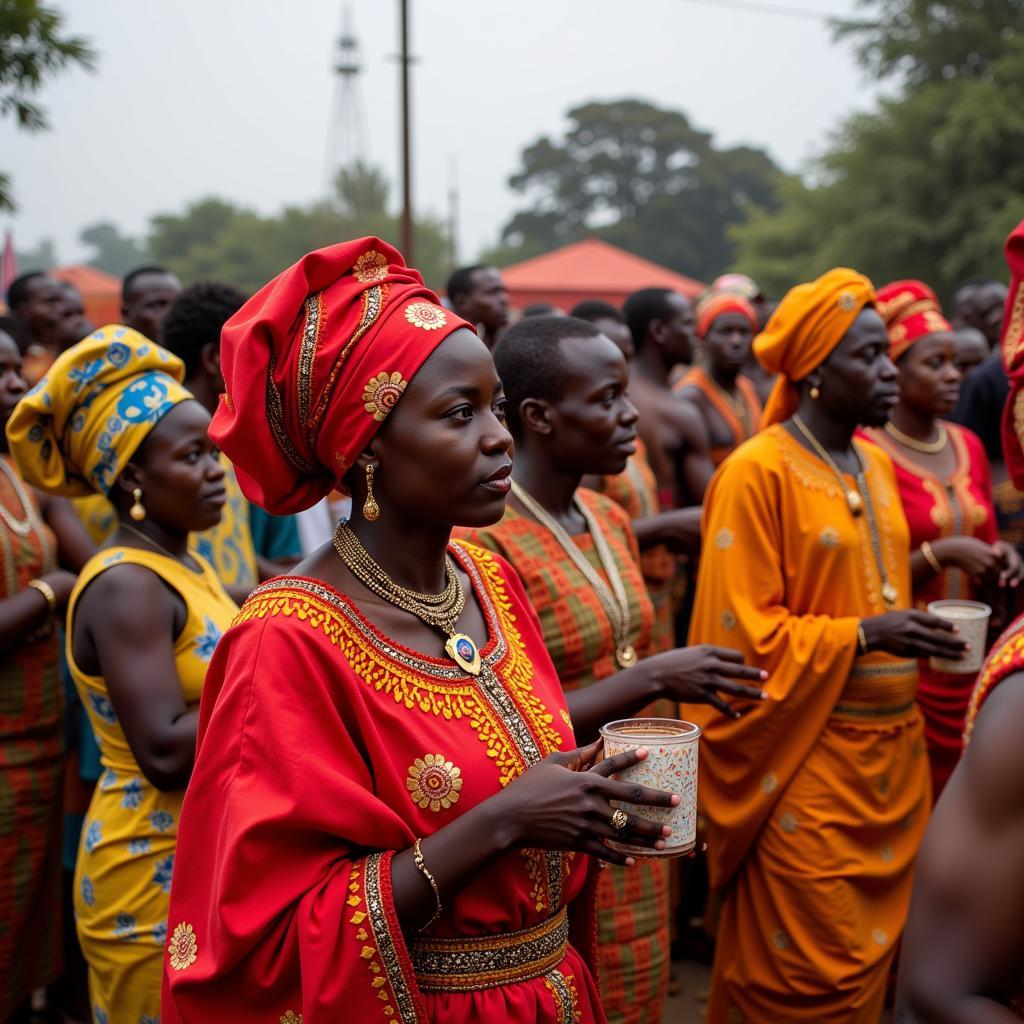African Colors and What They Mean: A Vibrant Tapestry of Culture
The striking array of colors found in African art, textiles, and ceremonies isn’t merely aesthetically pleasing; it reflects a deep connection to the continent’s history, beliefs, and way of life. Understanding what African colors mean unveils a rich tapestry of symbolism, revealing insights into the diverse cultures they represent.
 African Ceremony with Vibrant Colors
African Ceremony with Vibrant Colors
The Significance of Color in African Cultures
Unlike Western interpretations, where colors might be linked to emotions or abstract concepts, African color symbolism is often deeply rooted in the natural world and ancestral wisdom. Colors represent elements, social structures, and spiritual beliefs passed down through generations. They are not merely visual elements but powerful tools of communication and cultural expression.
A Guide to Common African Colors and Their Meanings
Red: The Color of Life and Death
Red holds a multifaceted significance in African cultures. It symbolizes the life-giving force of blood, representing physical vitality, ancestors, and the cycle of life and death. It’s often associated with strong emotions like passion, courage, and anger. In some cultures, red is worn during rites of passage and ceremonies honoring ancestors.
Black: The Color of Mystery and Power
Often associated with the night sky and the unknown, black represents mystery, power, and the spiritual world. It can symbolize authority, elegance, and sophistication. In some cultures, black is the color of mourning, while in others, it represents fertility and the promise of new beginnings.
White: The Color of Purity and Peace
White represents purity, peace, and spiritual enlightenment across many African cultures. It symbolizes goodness, innocence, and the afterlife. It’s often worn during purification ceremonies and rituals intended to connect with the divine.
Green: The Color of Nature and Prosperity
As the color of lush vegetation and abundant harvests, green represents growth, prosperity, and connection to the earth. It symbolizes hope, fertility, and healing. Green is often incorporated into celebrations of agriculture and rituals seeking abundance.
 African Landscape with Lush Green Vegetation – Prosperity
African Landscape with Lush Green Vegetation – Prosperity
Yellow: The Color of Wealth and Royalty
Across many African cultures, yellow, often associated with gold, symbolizes wealth, royalty, and spiritual enlightenment. It represents the sun’s warmth and life-giving energy. Yellow is often incorporated into regalia and adornments worn by leaders and spiritual figures.
Blue: The Color of the Sky and Spirituality
Blue holds a spiritual significance in many African cultures, representing the vastness of the sky and the heavens. It symbolizes peace, harmony, and the divine. Blue is often used in textiles and artwork depicting spiritual themes and celestial beings.
Gold: The Color of Divinity and Royalty
Gold holds a revered place in African cultures, symbolizing divinity, royalty, and spiritual purity. Its rarity and value make it a powerful symbol of wealth and prosperity. Gold is often incorporated into ceremonial objects, jewelry, and regalia.
The Language of Colors in African Art and Textiles
african waist beads are just one example of how African art and textiles utilize color to communicate cultural narratives and beliefs. The intricate patterns and vibrant hues woven into fabrics tell stories of heritage, ancestry, and social standing. Each color choice is deliberate, adding another layer of meaning to the artwork.
african badwork earring image beads art frequently feature intricate beadwork that incorporates a symphony of colors, each bead carefully chosen for its symbolic meaning.
African Colors in Contemporary Culture
The vibrancy of African colors continues to resonate in contemporary fashion, art, and design. From african american college hoodies showcasing bold prints to modern artists drawing inspiration from traditional color palettes, African color symbolism is finding new expressions in the global landscape.
Embracing the Rich Tapestry of African Colors
Understanding the meanings behind African colors allows for a deeper appreciation of the continent’s rich cultural heritage. It unveils a world where colors are not just visual elements but powerful tools for storytelling, cultural expression, and spiritual connection.
Expert Insight:
“The language of color in Africa is a complex and nuanced one,” says Dr. Abena Owusu, an expert in African art and symbolism. “It’s a language that speaks to the soul, revealing the beliefs, values, and histories of a people.”
As you explore the vibrant world of African culture, take note of the colors you encounter. Each hue holds a story, inviting you to delve deeper into the heart of Africa’s artistic and cultural tapestry.
Frequently Asked Questions about African Colors
What does the color purple represent in African culture?
Purple is often associated with royalty, wealth, and spirituality in many African cultures.
Do all African cultures share the same color symbolism?
While some common threads exist, color symbolism can vary significantly between different African cultures and regions.
Where can I learn more about specific color meanings in different African cultures?
Resources like academic journals, museums specializing in African art, and cultural centers can provide more in-depth information.
Looking for More Insights into African Life?
Explore our other articles on abstract african woman painting and african hairstyles cartoon to further delve into the diverse expressions of African culture.
Need help understanding African cultures?
Contact us at +255768904061, email us at [email protected], or visit our office at Mbarali DC Mawindi, Kangaga, Tanzania. Our team is available 24/7 to assist you.

